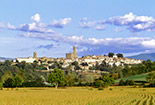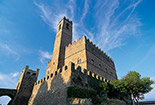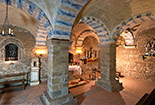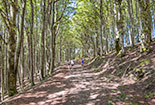THE TERRITORY OF THE MUNICIPALITY OF POPPI
in Casentino, a Tuscan valley with which you can get familiar in every detail through this site
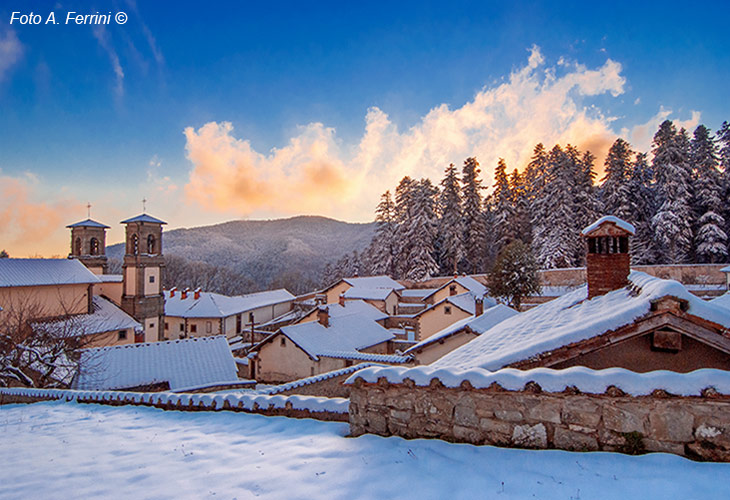
Texts and photos by Alessandro Ferrini ©
62 accurately described images of the municipal area of Pratovecchio Stia. Clik to elarge
The municipal area of Poppi
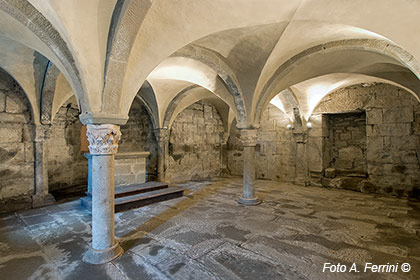 The medieval village of Poppi, located on the apex of a hill that rises next to the right bank of the Arno, is considered the architectural jewel of the Casentino. Its castle is the symbol not only of the town but of the whole valley. Poppi also means a municipal area that contains many interests: naturalistic, historical, religious, architectural, artistic. An area that descends from the Tuscan-Romagna Apennine ridge to the valley floor and climbs up the slopes of Pratomagno, arriving not far from the famous meadows of this large massif that divides the Casentino from the Valdarno.
The medieval village of Poppi, located on the apex of a hill that rises next to the right bank of the Arno, is considered the architectural jewel of the Casentino. Its castle is the symbol not only of the town but of the whole valley. Poppi also means a municipal area that contains many interests: naturalistic, historical, religious, architectural, artistic. An area that descends from the Tuscan-Romagna Apennine ridge to the valley floor and climbs up the slopes of Pratomagno, arriving not far from the famous meadows of this large massif that divides the Casentino from the Valdarno.
The part of the territory of the Municipality of Poppi located in the highest area of the Apennines is located within the National Park of the Casentinesi Forests, Monte Falterona and Campigna. The journey proposed by this web section begins from this mountain belt, which extends from Passo dei Mandrioli to almost Poggio Scali. In this area, located over seven hundred meters above sea level, is Camaldoli, a monastic place founded by San Romualdo in the second decade of the 11th century. This is divided into the Sacred Hermitage, at 1100 meters above sea level, and the Monastery, at 800 meters. Camaldoli as well as being a place of faith located among beautiful forests of which the monks were the creators and curators since the second half of the 11th century is also a place of art and of high historical value. The present architecture embraces a period ranging from Romanesque to Baroque. All this has contributed to giving Camaldoli a notoriety that goes well beyond local borders.
The area of the Apennine ridge above the Hermitage of Camaldoli is known as Giogana (in Song V of Purgatory - verse 116 - Dante calls it "great giogo"). Here is the beautiful GEA 00 ridge path which in about three hours leads us to Passo alla Calla passing through the panoramic Poggio Scali.
Not far from Camaldoli is Badia Prataglia, along the road of the Mandrioli Pass that leads to Romagna. This location can also be reached via a road that starts from the Sacred Hermitage and crosses the forest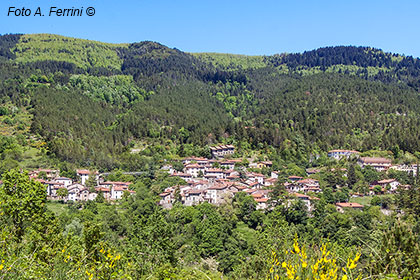 (closed in winter). The name of this town originates from an abbey that was founded in the last years of the 10th century in a mountainous area where there were large meadows. Initially this monastic place was very important, but over the course of a few centuries it had to submit to the nearby and more powerful Camaldolese monks who transformed the meadows into woods. Today the church remains of the original Abbey of Prataglia, completely rebuilt in the 14th century and then restored several times. Very interesting is its Romanesque crypt with even older capitals recovered from some other place. Today Badia Prataglia is a welcoming health resort that began to develop in the late nineteenth century after the opening of the Mandrioli Pass.
(closed in winter). The name of this town originates from an abbey that was founded in the last years of the 10th century in a mountainous area where there were large meadows. Initially this monastic place was very important, but over the course of a few centuries it had to submit to the nearby and more powerful Camaldolese monks who transformed the meadows into woods. Today the church remains of the original Abbey of Prataglia, completely rebuilt in the 14th century and then restored several times. Very interesting is its Romanesque crypt with even older capitals recovered from some other place. Today Badia Prataglia is a welcoming health resort that began to develop in the late nineteenth century after the opening of the Mandrioli Pass.
Coming down from Camaldoli towards Poppi we meet Moggiona. The ancient history of this small town is linked to Camaldoli. In practice, the inhabitants of the place were a sort of workers of the monks in the work of cutting the forest and subsequent reforestation. In 1776, with the dissolution of the County of Camaldoli by the Grand Duchy of Tuscany, the Moggione people found themselves without work and entered a profound poverty from which they emerged very slowly starting to make bigonce (in the local jargon bigoni), those wooden containers for the transport of the grapes during the harvest. This profession supported the country's economy until the 1960s. For this reason, "La Bottega del Bigonaio" was created in Moggiona, a sort of small museum where you can see various types of tubs, other objects always related to grape processing and the tools for making these. Moggiona is also sadly known for a Nazi fascist massacre which took place on 7 September 1944. This tragic event was the starting point for the exhibition on War and Resistance in the Casentino. Worth visiting is the church dedicated to Saints Jacopo and Cristoforo. There is a late sixteenth-century canvas that shows the Visitation of the Virgin Mary to Sant’Elisabetta with Saints Benedict and Romualdo, in honor of Camaldoli, and Jacopo and Cristoforo, owners of the church.
Returning to the road towards Poppi, just before the town of Avena, a detour to the right takes us in a few hundred meters to the lovely 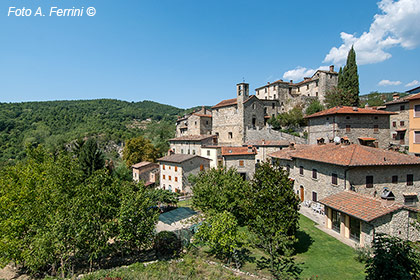 Church of Agna dedicated to San Bartolomeo and located in the open countryside. Its origins are very ancient. We find it mentioned in the papers of Camaldoli to whose hermits it was donated in 1037.
Church of Agna dedicated to San Bartolomeo and located in the open countryside. Its origins are very ancient. We find it mentioned in the papers of Camaldoli to whose hermits it was donated in 1037.
In Avena a road on the left leads in a couple of kilometers to Lierna. This small village originated from a castle guarding the valley of the Sova stream which in the 12th century was under the jurisdiction of the Guidi. Remains of the keep are visible in the building that took its place. The inhabited area is very well-kept, pleasant is its church dedicated to San Michele at the top of a staircase. Inside there are valuable works of art: a Deposition of Christ by the Sienese Pietro Sorri, late 16th century; the Sacrifice of Isaac by the Florentine Francesco Curradi, forties of the seventeenth century; and also from the same period, the Martyrdom of Sant'Agata, again by a Florentine, Francesco Curradi.
Once in Ponte a Poppi, taking the Regional Road 70 heading south (Bibbiena) after two kilometers, a detour to the left leads us to the nearby village of Memmenano. In his church dedicated to San Matteo we can see a glazed terracotta showing us Pentecost. It was built in the early 16th century by Andrea della Robbia and Luca della Robbia the Younger. If, on the other hand, we head north on the Strada Reginale (Pratovecchio Stia), after a couple of kilometers we reach Porrena. In the new church of the place dedicated to Santa Maria Assunta, another glazed terracotta is preserved. Its author is Santi Buglioni who created it in the third decade of the 16th century. The work shows the Madonna della Cintola with St. Thomas and St. Jerome.
Taking us to the west of the Poppi hill, from where we have the most interesting view of the village, we find a crossroads. Going up towards the historic center of the town, but then turning towards Ortignano, we can go and visit the Pieve di Santa Maria a Buiano. The church, which has been documented since the early 11th century, is part of an agricultural context. It had three naves and its dimensions were very large. Today only half of the central nave remains. The apse still maintains its original shape. 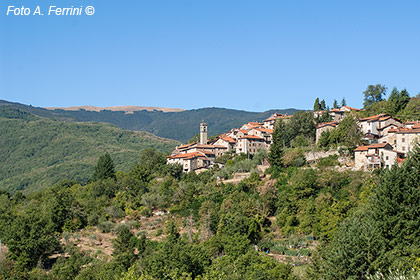 From the center of its floor it is possible to descend into its interesting and fascinating crypt.
From the center of its floor it is possible to descend into its interesting and fascinating crypt.
Returning to the crossroads and heading in the opposite direction we will reach Strumi. An abbey was built here around 980. This was short-lived because the Guidi at the time of the construction of their sumptuous palace in Poppi (13th century) wanted the monastic complex to move inside the castle walls (the current Badia San Fedele) . From Strumi we can quickly reach other towns, of which the most interesting is certainly Quorle.
From the crossroads a road climbs towards the slopes of Pratomagno and in about seven kilometers takes us to Quota, 700 meters high. The small village is very tidy. Its interior is characterized by a pleasant intertwining of alleys. The town originated from the Coita Castle, built by the Guidi at the end of the 12th century for the view it offered: from the valley of the Teggina stream to Bibbiena. Previously others had realized the important strategic position of this place. In fact, the medieval castle was built around a tower built by the Goths which the Lombards took over in the 7th century.



